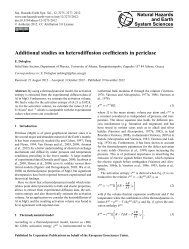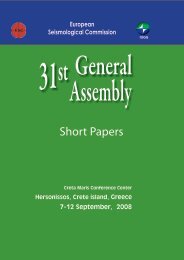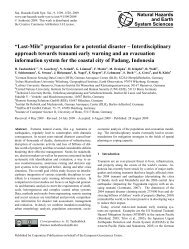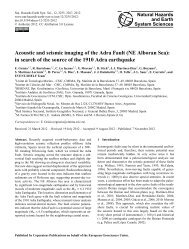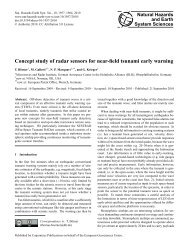implications for permafrost degradation and slope instability in the ...
implications for permafrost degradation and slope instability in the ...
implications for permafrost degradation and slope instability in the ...
Create successful ePaper yourself
Turn your PDF publications into a flip-book with our unique Google optimized e-Paper software.
R. P. Daanen et al.: Rapid movement of frozen debris-lobes 1531<br />
1<br />
2<br />
4<br />
Figure 11. Striations on <strong>the</strong> underside of a block of frozen silty debris <strong>in</strong>dicate slid<strong>in</strong>g motion <strong>in</strong><br />
Fig. 11. Striations on <strong>the</strong> underside of a block of frozen silty debris <strong>in</strong>dicate slid<strong>in</strong>g motion <strong>in</strong> <strong>the</strong> frontal lobe of FDL-A dur<strong>in</strong>g <strong>and</strong> after soil<br />
freez<strong>in</strong>g. Below is <strong>the</strong> orig<strong>in</strong>al ground surface, littered with recent organic matter, <strong>and</strong> above is <strong>the</strong> seasonally frozen ground that slid over<br />
<strong>the</strong> 3 orig<strong>in</strong>al <strong>the</strong> ground. frontal Ice lobe can be of seen FDL-A <strong>in</strong> cracks dur<strong>in</strong>g as well <strong>and</strong> as streaks after on soil <strong>the</strong>freez<strong>in</strong>g. underside from Below <strong>the</strong> slid<strong>in</strong>g is <strong>the</strong> motion. orig<strong>in</strong>al ground surface,<br />
littered with recent organic matter, <strong>and</strong> above is <strong>the</strong> seasonally frozen ground that slid over <strong>the</strong><br />
<strong>and</strong> 5 irregular orig<strong>in</strong>al subsidence. ground. The Ice trees can be respond seen by <strong>in</strong> grow<strong>in</strong>g cracks ad- as well m<strong>in</strong>us, as streaks likely on caus<strong>in</strong>g <strong>the</strong> underside <strong>in</strong>clusion offrom considerable <strong>the</strong> slid<strong>in</strong>g amounts of<br />
ditional wood on <strong>the</strong> lean<strong>in</strong>g side of <strong>the</strong> tree <strong>in</strong> an attempt<br />
to 6 ma<strong>in</strong>ta<strong>in</strong> motion. a vertical growth position. Tree r<strong>in</strong>g analysis of<br />
one drunken spruce tree grow<strong>in</strong>g on <strong>the</strong> surface of FDL-A<br />
showed 7 evidence of dist<strong>in</strong>ct shifts <strong>in</strong> direction ra<strong>the</strong>r than a<br />
cont<strong>in</strong>uous change <strong>in</strong> direction (Fig. 9). The tree r<strong>in</strong>gs <strong>in</strong>dicated<br />
8 that this tree <strong>for</strong>med compression wood (i.e., larger<br />
tree r<strong>in</strong>gs on one side of <strong>the</strong> tree trunk) over periods rang<strong>in</strong>g<br />
from one to four decades.<br />
organic matter under <strong>and</strong> with<strong>in</strong> <strong>the</strong> frozen debris-lobe.<br />
Permafrost creep occurs <strong>in</strong> areas with steep gradients <strong>and</strong><br />
is visualized <strong>in</strong> surface cracks <strong>and</strong> de<strong>for</strong>med trees (Fig. 2c).<br />
With <strong>the</strong> currently available data basal slid<strong>in</strong>g was not directly<br />
observed, but <strong>in</strong>direct evidence suggests that it occurs.<br />
Organic soils, overrun by <strong>the</strong> frozen debris-lobe, could provide<br />
a weak layer that allows slid<strong>in</strong>g as <strong>the</strong> weight of <strong>the</strong> debris<br />
pushes down <strong>the</strong> <strong>slope</strong>. Bucki <strong>and</strong> Echelmeyer (2004)<br />
identified such a slid<strong>in</strong>g layer <strong>in</strong>side <strong>the</strong> Fireweed rock<br />
4.7 Characterisation of movement processes <strong>in</strong> frozen glacier. O<strong>the</strong>r <strong>for</strong>ms of slid<strong>in</strong>g of <strong>the</strong> frozen debris <strong>in</strong> <strong>the</strong><br />
debris-lobes<br />
active layer have been observed, such as <strong>in</strong> Fig. 11.<br />
The major types of movements observed at our studied<br />
frozen debris-lobes <strong>in</strong>clude: (1) <strong>permafrost</strong> creep dur<strong>in</strong>g w<strong>in</strong>ter<br />
<strong>and</strong> summer, (2) basal slid<strong>in</strong>g, <strong>and</strong> (3) several <strong>for</strong>ms of<br />
active layer movement such as mudflows, detachment slides,<br />
gelifluction <strong>and</strong> slid<strong>in</strong>g of frozen soil slabs dur<strong>in</strong>g fall <strong>and</strong><br />
early w<strong>in</strong>ter freez<strong>in</strong>g. All <strong>for</strong>ms of movement are driven by<br />
gravity <strong>and</strong> largely oriented <strong>in</strong> <strong>the</strong> same down<strong>slope</strong> direction.<br />
As a result of movement, deep crevasses or cracks occur<br />
with<strong>in</strong> <strong>the</strong> frozen debris-lobe. These <strong>for</strong>ms of movement also<br />
cause trees to lean <strong>and</strong> become buried under debris at <strong>the</strong> ter-<br />
Down<strong>slope</strong> motion of seasonally frozen soil is common on<br />
steep terra<strong>in</strong> underla<strong>in</strong> by <strong>permafrost</strong>. A number of different<br />
movement types were observed <strong>in</strong> <strong>the</strong> field. Dur<strong>in</strong>g <strong>the</strong> summer<br />
of 2009, a steep portion of <strong>the</strong> term<strong>in</strong>us collapsed <strong>and</strong><br />
caused a mudflow <strong>in</strong> front of <strong>the</strong> time-lapse camera. Beg<strong>in</strong>n<strong>in</strong>g<br />
with <strong>the</strong> spr<strong>in</strong>g snowmelt, rapid movement of coarse<br />
debris <strong>and</strong> f<strong>in</strong>e sediment occurs as mudflows from <strong>the</strong> term<strong>in</strong>us<br />
<strong>and</strong> <strong>the</strong> sides of <strong>the</strong> frozen debris-lobe. As <strong>the</strong> summer<br />
progresses <strong>and</strong> <strong>the</strong> active layer deepens, mudflows <strong>in</strong>crease<br />
<strong>in</strong> size. Hourly time-lapse photographs revealed mudflows<br />
37<br />
on FDL-A dur<strong>in</strong>g or immediately after ra<strong>in</strong> events, with ra<strong>in</strong><br />
www.nat-hazards-earth-syst-sci.net/12/1521/2012/ Nat. Hazards Earth Syst. Sci., 12, 1521–1537, 2012



